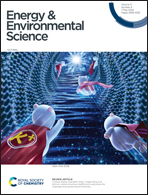Reactive silver inks: a path to solar cells with 82% less silver†
Abstract
Silicon heterojunction (SHJ) cells currently hold the efficiency record for crystalline silicon (c-Si) based devices of 27.09% and continue to show a promising pathway towards the practical limit of 28.5%. The efficiencies of these cells are typically limited by two main components that are closely related: the resistive losses of the contact layers across the device and the shading losses of the metallization. As the widths of the contacts are reduced to minimize shading, the resistive losses of these narrower contacts become increasingly important to manage. The higher resistivity of the low-temperature silver paste (LT-SP) grid metallization is a direct result of what is required to meet the low temperature compatibility requirements set by the amorphous silicon layers. Reactive silver ink (RSI) coupled with dispense printing offers a path to fabricate low-temperature metallization contacts with pure metal-like properties while using 82% less silver than LT-SP (16.4 mgAgvs. 89.2 mgAg). Here we present the potential of this advanced metallization, which has a unique contact geometry and can yield a total resistivity of 3.1 μΩ cm and contact resistivity of 3.2 mΩ cm2. This results in an efficiency gain of 1.1%abs when using an identical grid design as the LT-SP metallization. In addition, power loss analysis of the devices is performed and demonstrates how RSI metallization can achieve higher efficiencies than 22.29%, which is 2.09%abs above the LT-SP baseline by redesigning the contact grid and TCO optimization.



 Please wait while we load your content...
Please wait while we load your content...
